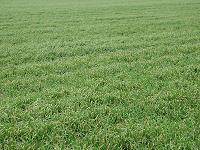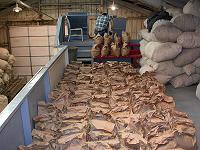

November 3, 2005 |
 |
|---|
| Question #1. When can I start grazing my wheat? Grazing of wheat should be delayed until the secondary root system has developed enough to anchor the plant. If producers start the grazing process too early the livestock will pull the wheat plant up by the roots and reduce the plant population. Producers should examine the wheat plant and determine if the secondary root system has adequately developed before livestock are allowed to graze. |
| Question #2. Is there a great disadvantage to planting in dry soil and waiting on rain later? The main challenge is getting the seed placed at the proper depth. For this time of year the target is 1.25 to 1.5 inches deep in dry soil. This is a good planting depth if the rain does not cause a lot of buildup of soil above the seed. A hard rain could compact the soil requiring the producer to breakup a crust. Otherwise, dry planting at this time should work just fine. |
 The rain in October leached most of the available nitrates below the root zone on newly emerged wheat and slowed down the potential plant development. The plant will suffer until the root expands far enough to extract the deeper nitrates or until an application of nitrogen is made. The older wheat has a deeper root system and has developed a significant amount of forage.
The rain in October leached most of the available nitrates below the root zone on newly emerged wheat and slowed down the potential plant development. The plant will suffer until the root expands far enough to extract the deeper nitrates or until an application of nitrogen is made. The older wheat has a deeper root system and has developed a significant amount of forage.
Producers should keep a watchful eye on the developing broadleaf weeds. When weed size becomes a concern the producers need to follow the label closely if they are using a hormone herbicide such as 2,4-D to control the weeds. Most of the 2,4-D labels indicate that the wheat needs to be past the tillering stage before applying the herbicide. You may need to switch over to some other herbicide such as Ally or Amber.
The results obtained from harvest aid tests conducted this year ranged from excellent to poor. The performance of the harvest aid was directly related to the maturity of the cotton bolls. Immature cotton had less boll opening and leaf defoliation than when the same materials were applied to mature cotton.
The removal of juvenile growth could only be achieved using more than four ounces of Ginstar. The juvenile growth could be desiccated using a minimum of either 0.75 ounce of Aim or 1.5 ounces of ET. The cooler air temperatures slowed the development of the abscission layer and that delayed the followup treatment of paraquat. Additional boll opening was obtained using adequate rates of Ethephon. Harvest on many dryland acres will not occur until after the first killing freeze. Several harvest aid reports were linked to last months newsletter. Each had a virtual tour so you could see what the treatments looked like. Attached is the last harvest aid report from our region this season, it was concluded on October 31, 2005.
How cold is too cold? If a temperature is reached that causes ice crystals to form in the plants tissue, then the plant will be injured. For cotton, that temperature is between 28o and 30oF. For some producers the cold temperature on October 25 had little impact. However, in some low elevation areas the cotton was killed.
|
Question #3. Why did the cotton leaves turn purple? This was primarily due to the cloudy weather that we had in early October. There was not enough sunlight available each day to reduce the carbohydrate stress in the cotton plant. This lack of sunlight basically caused the cotton plant to self destruct. The cotton plant had to extract needed developmental materials from the plant leaves (chloroplast cells), this resulted in a reduction of green cells which allowed the hidden leaf color to show which is reddish purple in the cotton raised in our area. These reddish purple leaves are not very efficient and the progress of the boll maturity is very slow. |
 The ginning date for District 6 is November 21 for District 7 it is November 22. If you can assist in ginning cotton please contact me. We usually need four people to get the job done. I need to let all the cotton producing counties know who is going so they can make the necessary arrangements to drop off their gin samples. Attached is a blank gin sheet that will need to be filled out and sent with your cotton samples. The seven digit sample number is a combination of three numbers; the county number is the first three digits, the producer or plot number is digits 4 and 5, and the sample is assigned a number between 01 and 99 which makes up digits 6 and 7. By using this code it helps to keep samples from getting lost. Try to have your gin samples between 600 and 650 grams. Thanks.
The ginning date for District 6 is November 21 for District 7 it is November 22. If you can assist in ginning cotton please contact me. We usually need four people to get the job done. I need to let all the cotton producing counties know who is going so they can make the necessary arrangements to drop off their gin samples. Attached is a blank gin sheet that will need to be filled out and sent with your cotton samples. The seven digit sample number is a combination of three numbers; the county number is the first three digits, the producer or plot number is digits 4 and 5, and the sample is assigned a number between 01 and 99 which makes up digits 6 and 7. By using this code it helps to keep samples from getting lost. Try to have your gin samples between 600 and 650 grams. Thanks.
Don't forget to send me your cooperators information. Attached is the information I need to help in writing up the result demonstration reports. It provides the information needed for the methods and materials section of the report. You should already have this completed; if not try to get the information when you are harvesting the plot.
On November 14, there will be a training conducted at Abilene for producers needing to obtain a Private Applicators license. For more details and to register for the meeting call Gary Bomar at (325) 672-6048.
On November 30, a five-hour CEU course will be held at Eldorado. This training is being hosted by Texas Cooperative Extension and the Texas Department of Agriculture. The target audience is ag producers and home owners. For more details and to register for the meeting call (325) 853-2132.
On December 8, a five-hour CEU course will be held at Brady. This training is being hosted by Texas Cooperative Extension and the Texas Department of Agriculture. The target audience is ag producers and home owners. For more details and to register for the meeting call Jerry Kidd at (325) 597-1295.
On December 14, a five-hour CEU course will be held at the Taylor County Extension Office. This training is being hosted by Texas Cooperative Extension and the Texas Department of Agriculture. The target audience is ag producers and home owners. For more details and to register for the meeting call Gary Bomar at (325) 672-6048.
 November 1, Taylor County, Gold Star Banquet
November 1, Taylor County, Gold Star Banquet
 November 2, District Office, Administrative Meeting
November 2, District Office, Administrative Meeting
 November 4, District Office, Teleconference Call
November 4, District Office, Teleconference Call
 November 7, District Office, District 7 Office Conference
November 7, District Office, District 7 Office Conference
 November 7, Taylor County, Small Grain Task Force Meeting
November 7, Taylor County, Small Grain Task Force Meeting
 November 9-12, Colorado Springs, CO, National ESP Meeting
November 9-12, Colorado Springs, CO, National ESP Meeting
 November 14 & 15, Potter County, TWIG Meeting
November 14 & 15, Potter County, TWIG Meeting
 November 21 & 22, Lubbock County, Gin Cotton
November 21 & 22, Lubbock County, Gin Cotton
 November 24 & 25, Holiday,
November 24 & 25, Holiday,
 November 28 & 29, Brazos County, 790 Project Group Meeting
November 28 & 29, Brazos County, 790 Project Group Meeting
 November 30, Schleicher County, CEU
November 30, Schleicher County, CEU
 December 2, District Office, Southern Rolling Plains Cotton Growers
December 2, District Office, Southern Rolling Plains Cotton Growers
 December 5, District Office, Office Conference
December 5, District Office, Office Conference
 December 6 & 7, Brown County, Professional Board Meetings
December 6 & 7, Brown County, Professional Board Meetings
 December 8, McCulloch County, Multi-County CEU Meeting
December 8, McCulloch County, Multi-County CEU Meeting
 December 14, Taylor County, CEU Course
December 14, Taylor County, CEU Course
 December 21 - 31, Potter, Randall, & Deaf Smith Counties, Christmas Holidays
December 21 - 31, Potter, Randall, & Deaf Smith Counties, Christmas Holidays
| Sincerely,
|